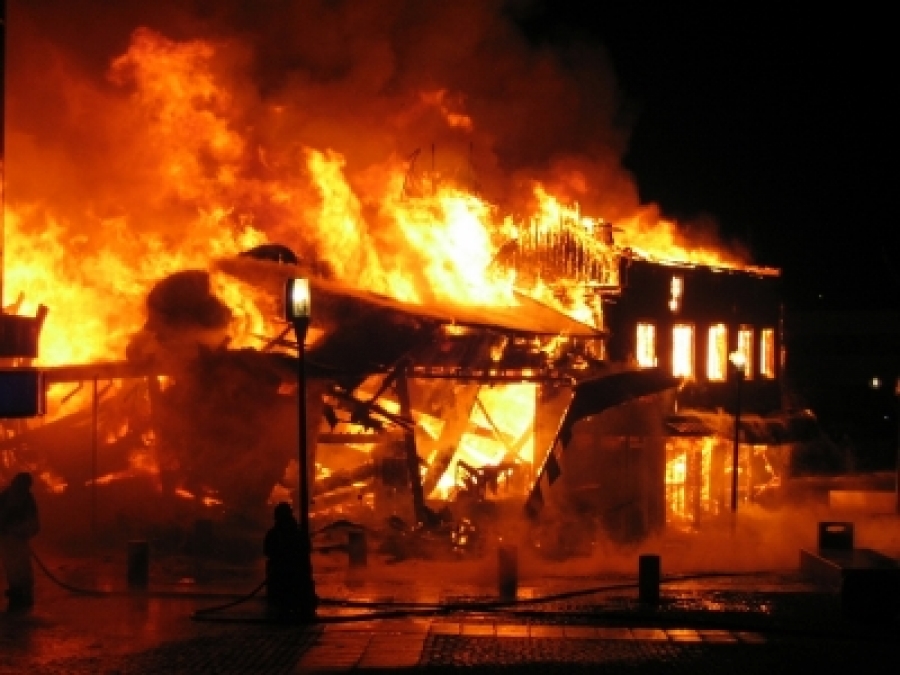Fire Dampers
Fire dampers are dampers which are forced to close in the event of a fire. There are different kinds of fire dampers, and they are classified according to the following factors: how they are actuated or forced to close; the physical constraints of their installation; and the fire rating of the ceiling, floor, or wall being penetrated.

Topic Summary
There are four primary methods of actuation for fire damper closure in the event of a fire: electrical, thermal, pneumatic, and hydraulic. Within each method there can be variations in the arrangement.
- Electrically actuated damper: When a fire is detected, a signal is sent to the fire damper actuator motor to energize it. It energizes and closes the damper.
- Thermally actuated damper: Works with a fusible link and may be installed horizontally, as in a floor or ceiling application, or may be installed vertically as in a wall application. Within a wall, the damper may be installed so that the fire damper drops down to shut off the flow of air or it may be installed to close horizontally. In the case of horizontally closing dampers, a spring must be utilized to force the damper to close. The fusible link serves to hold the damper open. When a fire is detected, the fusible link melts and allows the damper to close. There are different temperatures of fusible links. If replacing a fire damper, verify the temperature of the fusible link.
- Pneumatically actuated damper: Works in a similar way as the electric damper, but depends upon compressed air to activate the dampers. Pneumatic controls used to be the most popular, but the pneumatic tubing and piping could easily develop leaks. Over time, most pneumatic control systems have been replaced by direct digital controls or electrical.
Fire separations are rated in time. A floor and a ceiling are always fire rated; walls may or may not be rated. Wherever a rated element is penetrated with ductwork, the fire damper installed must match the rating of the element it is penetrating.
The primary purpose of a fire damper is to stop the flow of air, and therefore, of oxygen, which is one of the components required to sustain a fire. A secondary purpose is to stop the transmission of smoke. Being overcome with smoke kills more people annually than the fires themselves. The Center for Disease Control and Prevention states, "Most victims of fires die from smoke or toxic gases and not from burns (Hall 2001)".
The first and most obvious benefit of installing fire dampers is the protection of occupants where a fire has been detected. The second benefit is the protection of those who might be fighting the fire. The third benefit is to save the goods and equipment stored in the building. The fourth benefit is to save the building itself. Fire dampers may be required for obtaining a building permit and/or lowering insurance costs. Also, fire dampers may be required in either the supply duct or return duct (or both) surrounding each air handler or furnace. There are a few drawbacks to fire dampers, but they pale in importance when compared to the benefits. The first disadvantage of fire dampers is that they have to be reset after a fire, and the second is that they add to the construction costs.
Of all the components that make up a fire-protection system, fire dampers are the most difficult to maintain. Yet random checks of many facilities show that maintenance personnel cannot access the smoke dampers for inspection or testing. In many cases, the installer did not provide duct access panels. Maintenance and engineering managers can improve the performance of their fire-safety systems by installing access doors at each fire damper and implementing a comprehensive maintenance program, which consists of regular inspections (at least once a year), and testing and maintenance follow-up when deficiencies are discovered. The testing should include checking for bent or broken tracks, warped or lose dampers, and accumulated dirt in the tracks and release mechanism. Make certain no fire damper has been permanently wired in the open position. With the alarm system deactivated, check the operation of the smoke damper to verify it is fully closed. In addition to these items, when routine performance checks occur on an HVAC air distribution system and low air flow values are detected, check to make sure that the fire dampers have not been damaged and closed or partially closed.
NFPA 90A requires that fire dampers must be operated prior to building occupancy. At the point of construction, if a damper fails to operate freely, deficiencies should be corrected or the damper should be replaced with a working damper. Also, after a fire, all fire dampers are required to be reset and should be also be proved to be operational.
Manufacturers include, but are not limited to: Grainger, Enviro-Tec, Air Balance, Ruskin, and Louvers & Dampers. Fire dampers should be installed with strict accordance to manufacturer's recommendations and all governing bodies having jurisdiction. Fire dampers and installations should prove to comply with all the fire codes and any other governing body having jurisdiction.

Buildipedia Staff
The Buildipedia research and writing staff consists of dozens of experienced professionals from many sectors of the industry, including architects, designers, contractors, and engineers.
Website: buildipedia.com/


